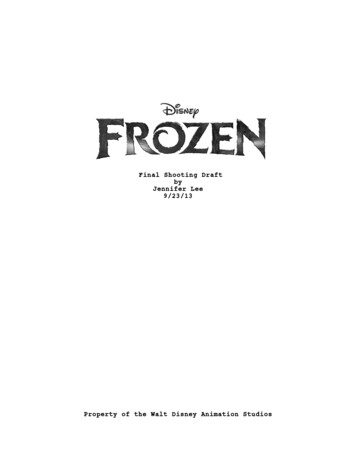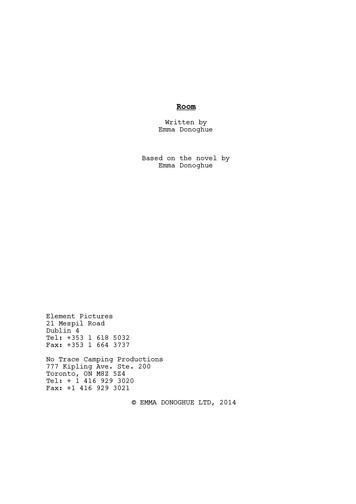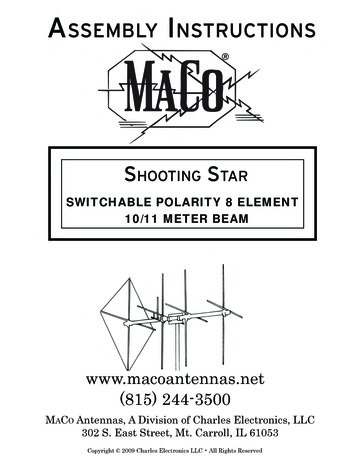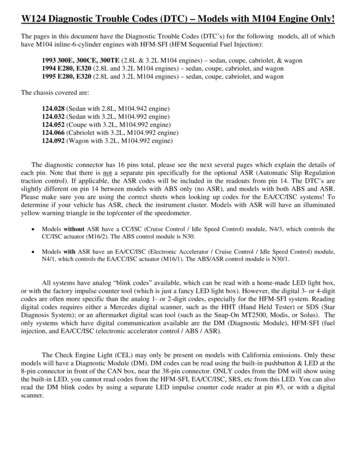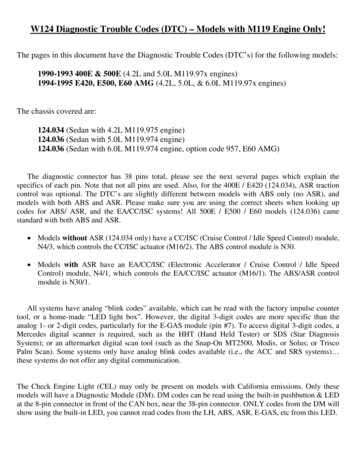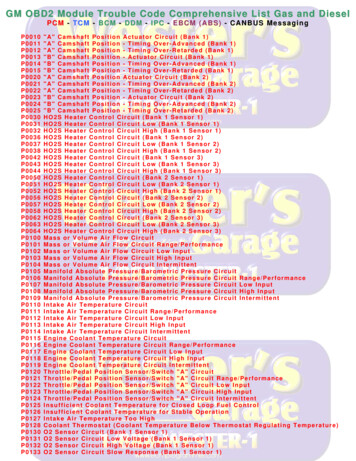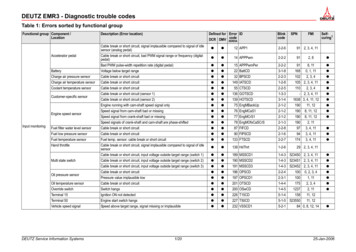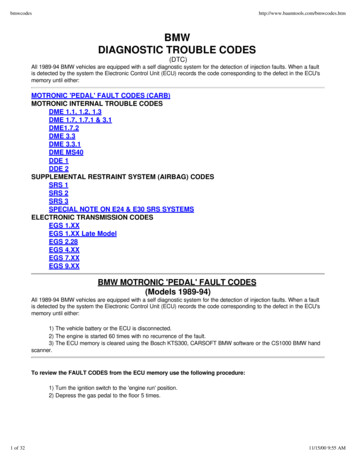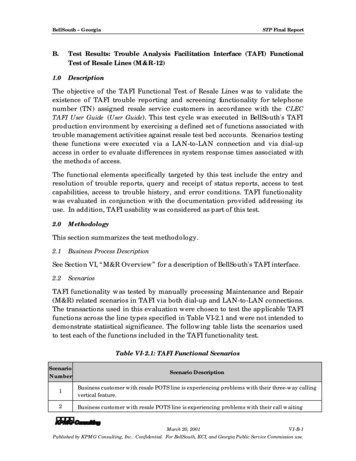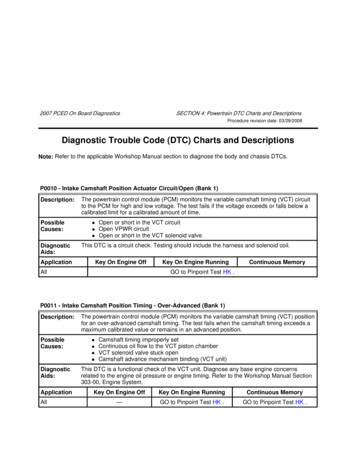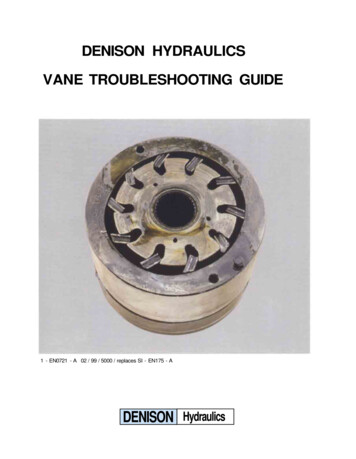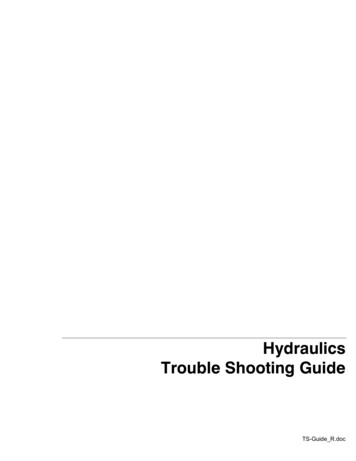
Transcription
HydraulicsTrouble Shooting GuideTS-Guide R.doc
Table of ContentsCondensed Table. 1Expanded TableValves . 3Cylinders . 3Boosters . 4Fluid Motors . 5Vane Pumps. 6Radial Piston Pumps . 9Hydraulic Systems . 11TS-Guide R.doc
Condensed Table - Causes of Trouble and Their Effects in Hydraulic InstallationsSource of Trouble,EffectsExcessive Noises1Mechanical Drive1. coupling wronglyaligned2. coupling loose3. coupling defective4. loose mounting npump and/or motordefective5. other transmissionelements loose6. pump or motordefective7. wrong direction ofrotation8. noise damping notincorporated in design2Suction LineSuction lineresistancebecause:1. tap or cock in thesuction line closed2. suction filterclogged or toosmall3. suction lineblocked or leaking4. suction line haswrong dimensions(i.e.: ID) or has toomany bends5. fluid level too lowBInsufficient Powerand Torque at thePower Take-offs(pressure too low)1. power transmissiondefective V-belt ortoothed belt slipping2. direction of rotationwrong3. motor defective4. key sheared off atpump or motorAs 2 ACJerky Cylinder andMotor Movements(variations inpressure anddelivery flow)As 1 A 1 thru 7As 2 ADPower Take-offeither does not turnat all, or - tooSlowly (insufficientor no delivery flow)As 1 A 1 thru 7As 2 AEExcessiveOperatingTemperatureFFoaming ofHydraulic FluidGCylinder Runs OnHLine Shocks whenSwitching TakesPlaceIPump Switches onand off too OftenATS-Guide R.doc1. suction line leaks2. fluid level too low3. wronglydesigned reservoir3Pump1. pump is turningtoo fast2. max pumppressure exceeded3. charge pumpdefective4. shaft seals orseals on suctionside are defective5. pump defective6. pressure andreturn linesconnected wrongly7. control systemoscillating8. As 1 A 81. internal leakagedue to wear2. unsuitable type3. pump defective4. end-of-controlpressure set toolow, or controlelement defective4Pressure Line1. linemountingsmissing or loose2. lines havebeen wronglylaid3. ID too small4. As 4 C5Return LineAs 4 A5. returnterminatesabove fluidlevel6. return filterblocked6Pressure Valves1. valve chatter dueto dirt on valveseat, valve worn2. insufficientdampening(unsuitable type)3. flow noises whenoperating4. unsuitablecharacteristic curve5. wrong design1. leakages2. excessive lineresistance3. pressure filterblocked1. excessiveline resistance2. return filterblocked1. with variablepumps, the controlsystem is defective2. pump defective3. systemconditions affectingthe pump controlsystem (DMV,SRV)4. unsuitable pilotvalve1. internal leakagedue to wear2. pump defective3. inlet and returnlines connectedwronginstallation notbleedcompletelyAs 5 B1. operatingpressure set toolow2. internal leakagedue to wear3. dirty or damagedvalve seat4. broken spring5. unsuitable type(setting range toolow)As 6 A 1 & 23. excessive lengthof undampedremote control line4. unsuitableremote controlvalveAs 4 BAs 5 B1. reduction inefficiency due towear2. with variablepumps, the controlsystem is defective3. rotational speedand/or deliveryexcessive1. shaft packings orseals on thesuction sidedefective2. leakage - oil lineterminates abovefluid level1. ID too small,causing frictionalresistance2. pressure filterblockedAs 4 E1. returnterminatesabove fluidlevel2. vortex effectdue to wronglylaid lines1. elasticity ofhoses excessive2. lines not bledAs 4 A5. the linesystem storagevolume isexcessive1. pump defective2. in the case ofaccumulatorinstallation, thepump is too smallPrinted 5/9/02As 6 Bwith sequentialcontrol:6. sequence valvesetting is too high,or valve isdefective1. constant deliveryflow is too high2. unsuitable valvetype (ID too small)3. pressure settingtoo high4. response timetoo longlines loose1. switches tooquickly2. restrictors ororifices damagedSequence valve orshut off valve haswrong setting1
Condensed Table - Causes of Trouble and Their Effects in Hydraulic Installations (continued)Source of Trouble,Effects7Flow ControlValves1. valveoscillates andexcites the othercontrol elementsto oscillation2. flow noises3. as 3 A 7AExcessive NoisesBInsufficient Powerand Torque at thePower Take-offs(pressure too low)1. pressurelossesexcessive2. false setting3. valvedefective4. unsuitabletypeCJerky Cylinder andMotor Movements(variations inpressure anddelivery flow)1. valve dirty2. As 7 A 1DPower Take-offeither does notturn at all, or - tooSlowly (insufficientor no delivery flow)EExcessiveOperatingTemperature1. through flowset too low2. unsuitabletype(settingrange too low)3. valve blocked(dirt)1. through flowset too low(excessivepump deliverythroughpressure reliefvalve)2. valvedefectiveFFoaming ofHydraulic FluidCylinder Runs OnGHLine Shocks whenSwitching TakesPlaceIPump Switches onand off too OftenTS-Guide R.doc8Directional ControlValves1. valve chatters, dueto defective solenoid,or the voltage is toolow2. valve defective dueto dirt or wear3. through flowexcessive4. pilot pressurevariations5. on valvesw/adjustable damping,the adjustment hasnot been carried out6. check the electricalcontrols1. wrong switchedposition (e.g.pressurelesscirculation does notswitch off)2. solenoid defective3. internal leakagedue to wear4. excessive flowspeeds5. spool jamsAs 8 A9Fluid10Drive (cylinder,motor, etc.)1. wear of runningsurfaces2. as 3 A 711Others1. viscosity too low,excessive leakages2. viscosity toohigh, excessiveflow resistance3. fluid foams1. internal leakages(e.g. cylinderpacking is worn)2. refer to 10 A3. excessiveinternal friction (lowefficiency)1. in the case of pressure controls,there is a defect in the open-loop (orclosed-loop) control circuit)2. display instruments defective1. hydraulic fluiddirty2. hydraulic fluidfoams1. Stick-slip effectdue to the frictionof the cylinderpackings being toohigh.2. operating belowlower limit of motorspeedAs 10 B4. power take-offblocked (.g. pistonseizure)insufficient load counter-balance (e.g.lowering control valve)1. cavitationproblems because:a) fluid level toolowb) viscosity toohigh (temperaturetoo low)2. fluidcontaminated anddirty, leading todamage andblockage ofequipment3. fluid foamsAs 8 B5. spool sticking6. manually operatedvalves (cocks) not inthrough flow positionAs 9 B1. leakage losses toohigh2. pressure circulationfails to switch on3. spool stickingAs 9 B1. losses inefficiency due towear2. internal frictiontoo high (poor levelof efficiency)3. internal leakagelosses1. conditions for starting not fulfilled(pump control system defective)2. electrical in-line open circuit (plug inconnections)3. signaling elements (e.g. pressureswitch wrongly set or defective, limitswitch not contacted1. cooling performance of the assembly(or installation) insufficient in relation tothe installed power or the operatingtime.2. pressureless circulation not provided(or does not switch on) during longworking breaks (with pump still running)3. insufficient hydraulic fluid in theinstallation4. coolant valve fails to switch5. thermostat set too high6. coolant not switched on or no coolantavailable, an defective7. coolant temperature too high8. surrounding temperature too high9. deposits in radiator10. insufficient heat dissipation due tonoise reduction measuresUnsuitable make1. switching time settoo low2. defective solenoidcause leakage invalve3. valve dirty1. switching time settoo fast2. unsuitable type(opening crosssection changes tooquickly)Foaming of thehydraulic fluid1. internal leakages2. faulty bleeding1. pilot controlled check valve fails toclose immediately because:a) seat is dirty or damagedb) technical switching fault2. limit switch fails to switch1. excessive forcesand masses2. no dampingin accumulator installations, throttleshave not been fitted in front of theswitching valvesin installations w/accumulators,1. the gas precharge too low2. bladder (diaphragm) defective3. pressure switch set incorrectlyPrinted 5-9-022
VALVESExpanded ILS irt in system1.Drain and flush system. Disassemble and clean, if necessary.2.Restricted drain2.Small fittings or pipe.3.Pilot pressure low3.Check pilot pressure system.4.Malfunctions of solenoids4.Check for proper source voltage and frequency. Removesolenoid and check fields.5.Distortion of valve body5.Align body and piping to remove strains.1.Dirt in system1.Disassemble, clean, and flush.2.Blocked drain2.Inspect for plugs or foreign matter.3.Pilot pressure off3.Check source of pilot pressure.4.Solenoids inoperative4.Check electrical source and solenoid fields.5.Distortion5.Align body and piping to remove strains.6.Improper re-assembly afteroverhaul6.Use parts drawing to check proper assembly.1.Improper installationconnections1.Check installation drawings.2.Improper assembly of valves2.Check parts and drawings.3.Spool installed backwards3.Reverse spool end for end.CYLINDERSTROUBLECAUSEREMEDY1.Valves sticking or binding1.Check for dirt or gummy deposit. Check for contamination ofoil. Check for air in system. Check for worn parts. Excessivewear may be due to oil contamination.2.Cylinder sticking or binding2.Check for dirt, gummy deposits or air leaks as above. Checkfor misalignment, worn parts or defective packing.3.Sluggish operation duringwarm-up period3.Viscosity of oil too high or pour point too high at startingtemperature. Change to oil with lower viscosity or betterviscosity index and lower pour point. An immersion heaterplaced in the oil may help under severe cold conditions.4.Pilot control pressure too low4.Control line may be too small, or metering choke valve notworking properly.5.Internal leakage in cylinder5.Repair or replace worn parts and loose packing. Check oil tosee that viscosity is not too low. Check for excessivecontamination or wear.6.Air in system6.Bleed air and check for leaks. Check to see that oil intake iswell below surface of oil in reservoir. Check pump packing andline connections on intake side by pouring hydraulic oil oversuspected leak. If noise stops, the leak has been located.Tighten joints or change packing or gaskets where necessary.ERRATICACTIONTS-Guide R.docPrinted 5-9-023
BOOSTERSExpanded TableTROUBLEBOOSTERNOTOPERATINGBOOSTER ce valve set too high1.Back off pressure adjusting screw of sequencevalve until booster starts to operate.2.Valve closed between pump andbooster2.Carefully check piping and valving.3.Valve closed between booster exhaustand reservoir3.Remove all valving from this line unless thefunction and operation of such valving isthoroughly understood.4.Pump not delivering oil or developinginsufficient pressure4.See pump trouble chart.5.Orifice at ends of control spool pluggedwith foreign matter5.Remove pipe plugs on both ends of booster bodyand clean orifice with air or wire.6.Pilot ram or pilot piston are tight orsticking6.Remove plugs outside pilot pistons on each end ofbooster. Check tightness of rams and pistons with3/16” cap screw. Look for dirt or chips. Dresswith crocus cloth if necessary.7.Main operating ram jammed7.Remove one or both heads as necessary forinspection. Renew main piston if badly scored byforeign matter. Whenever the heads are removedfrom the booster, the head gaskets and the highpressure seal between the head and the boosterbody must be replaced with new ones.8.Check valves jammed8.Inspect the four check valve assemblies fordamage. When reassembling, do not force springseat into place too hard.1.Booster not operating1.See section entitled “Booster Not Operating.”2.Excessive leakage of high pressure2.See section entitled “Booster Operating Rapidlyand Continuously.”3.Pump pressure not adjusted properly3.Booster pressure will be in proportion to pumppressure according to ratio stamped on booster.Adjust pump to desired pressure.4.Back pressure in booster exhaust line4.Inspect exhaust line for restriction. Should be 1”standard pipe area to reservoir. Remove anyvalves in this line unless function is thoroughlyunderstood.5.Spring loaded resistance valve betweenpump and booster5.Pressure drop between pump and booster willaffect apparent booster ration. A small hole drilledin disc of resistance valve, if used, will allowproper pressure ratio at end of cylinder stroke.TS-Guide R.docPrinted 5-9-024
BOOSTERS (cont.)TROUBLEBOOSTEROPERATINGRAPIDLY ANDCONTINUOUSLYWITHOUTBUILDING UPPRESSUREExpanded TableCAUSEREMEDY1.Incorrect valving in circuit1.See circuit drawing for typical booster circuit.Sequence and check valves or adequatesubstitutes are usually essential in most boostercircuits.2.Sequence valve incorrectly adjusted2.Tighten pressure adjusting screw sufficiently toprevent booster from operating. With correctpump pressure adjustment, and with operatingcylinder at end of stroke, back off adjusting screwuntil booster operates.3.Excessive leakage of high pressure invalves between booster and cylinder orin cylinder packing3.Locate point of leakage by isolating high pressurein separate pieces of equipment.4.Excessive leakage of high pressurewithin booster4.Isolate booster to verify source of trouble. Tightenhead bolts. Lap or replace four high pressurecheck valves as needed. If trouble continues,remove heads and inspect ram for scoring.Replace ram and “O” ring assemblies with newparts if needed. Replace rings on small ram.Excessive force may cause spring seat to buckle,jamming check valve.FLUID MOTORSTROUBLEMOTORTURN
Hydraulic Systems .11 . TS-Guide_R.doc Printed 5/9/02 1 Condensed Table - Causes of Trouble . 6. pump or motor defective 7. wrong direction of rotation 8. noise damping not incorporated in design Suction line resistance because: 1. tap or cock in the suction line closed 2. suction filter clogged or too small 3. suction line blocked or leaking 4. suction line has wrong dimensions (i.e .

